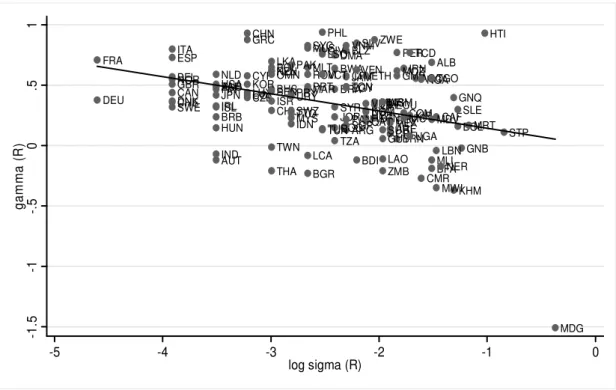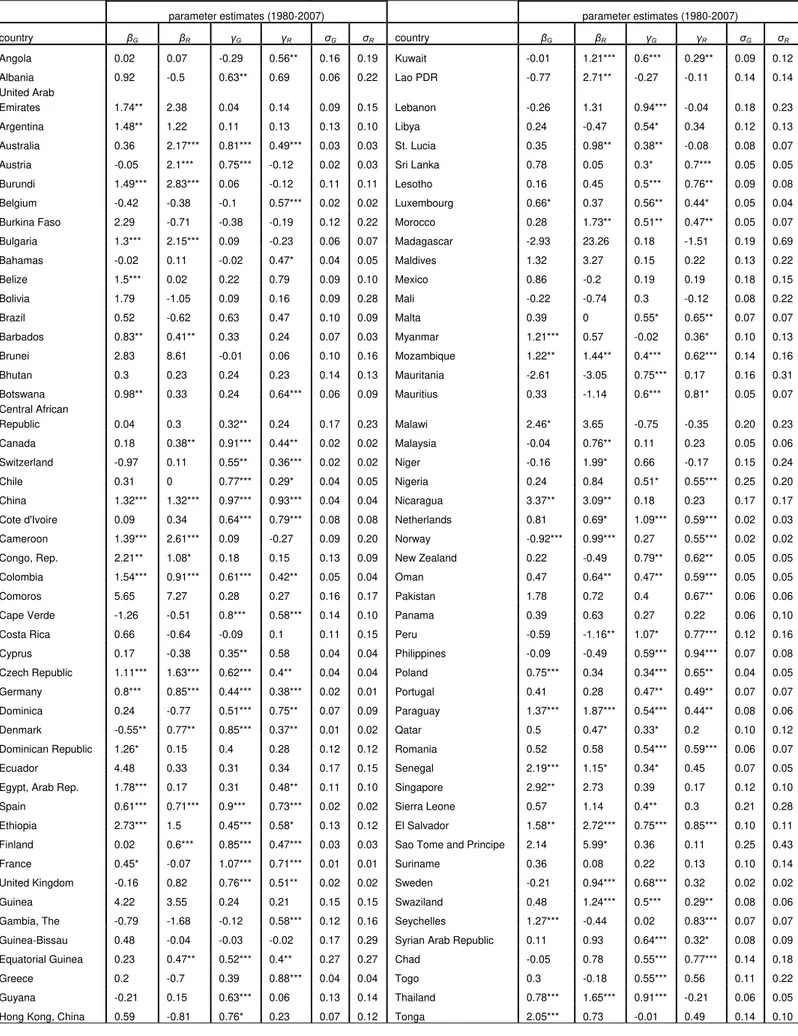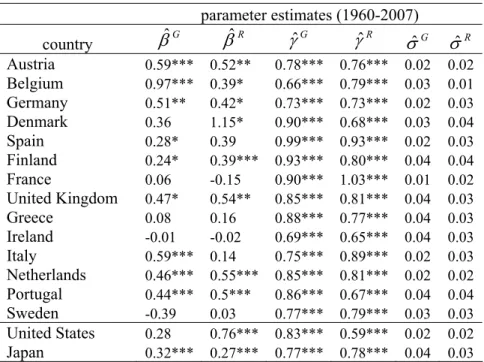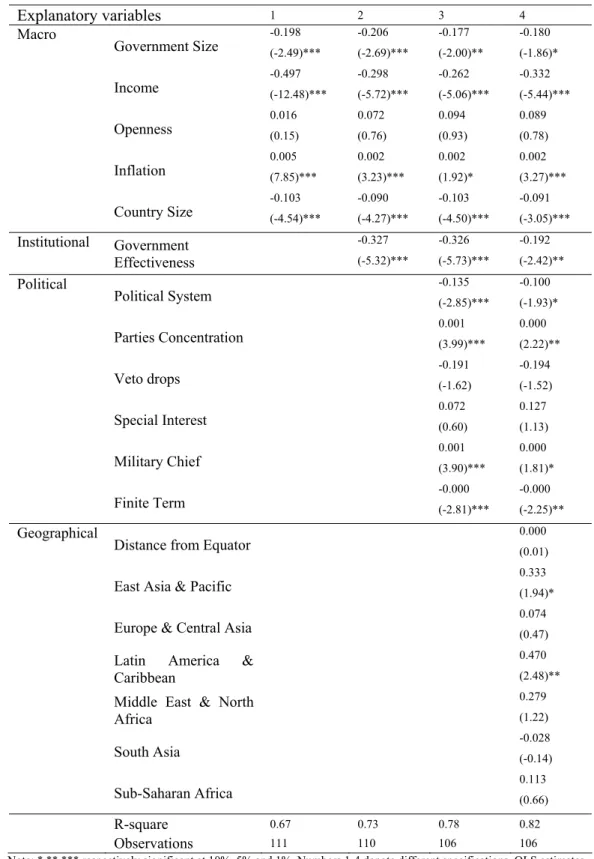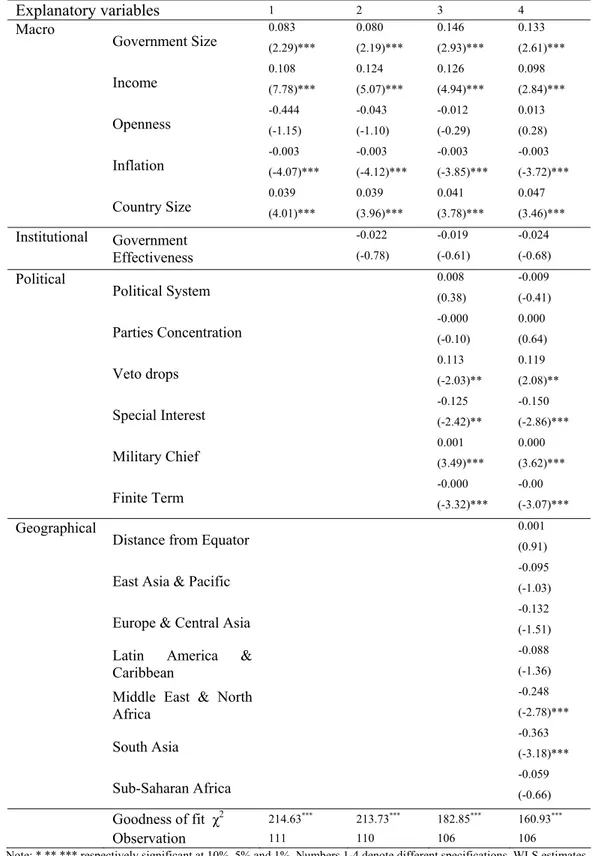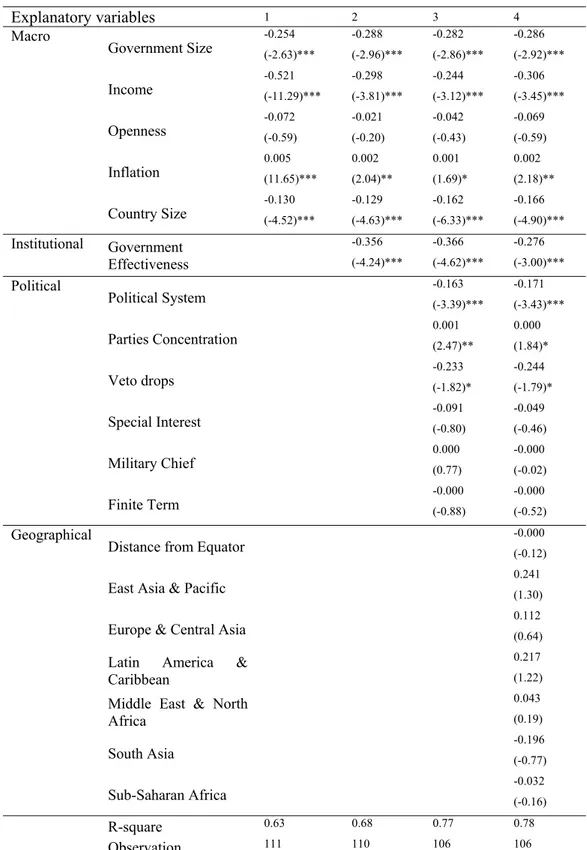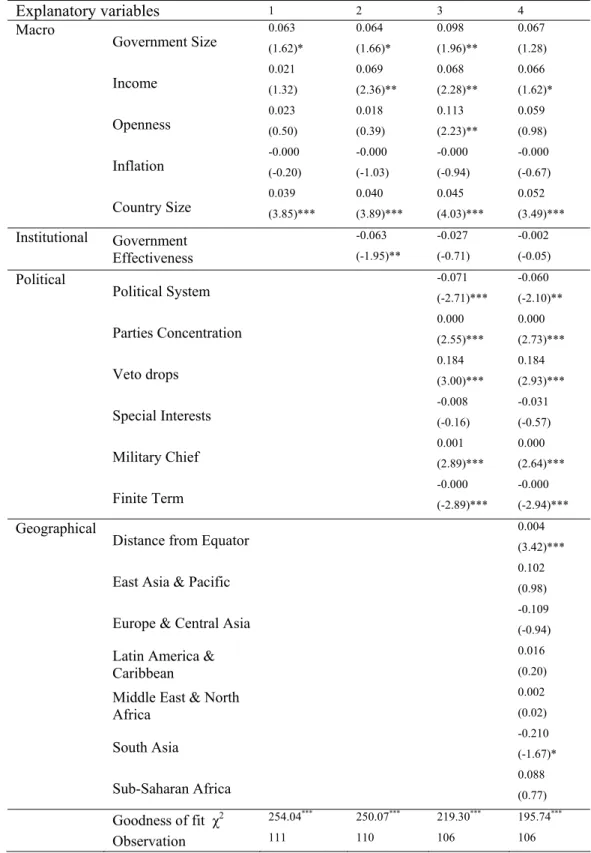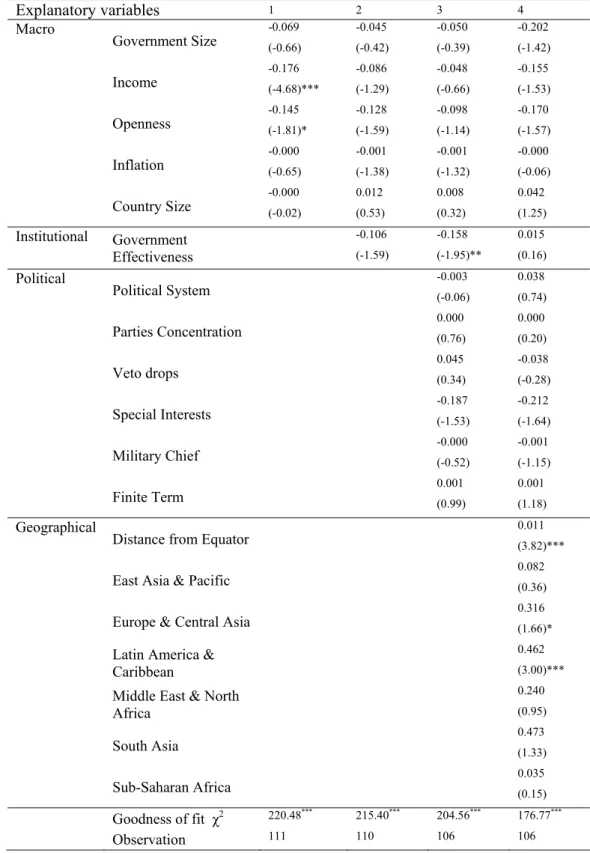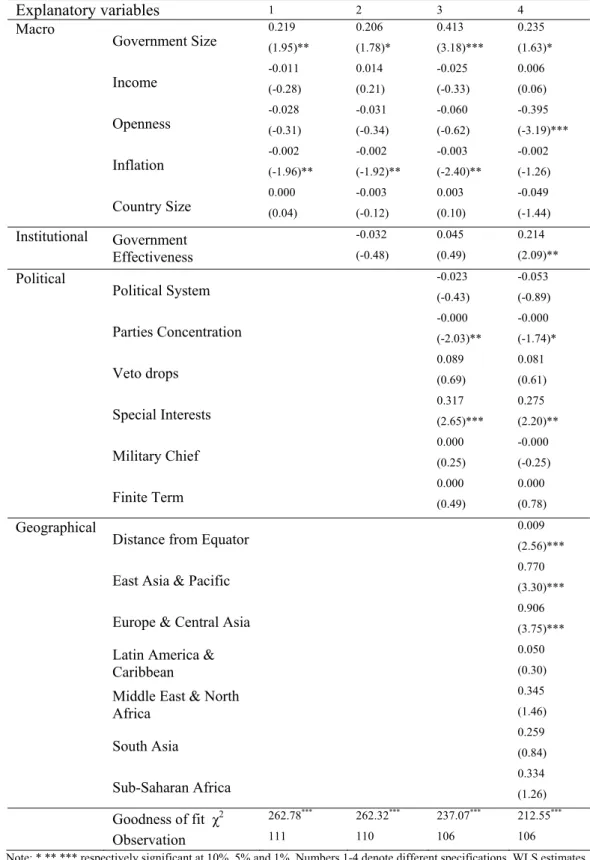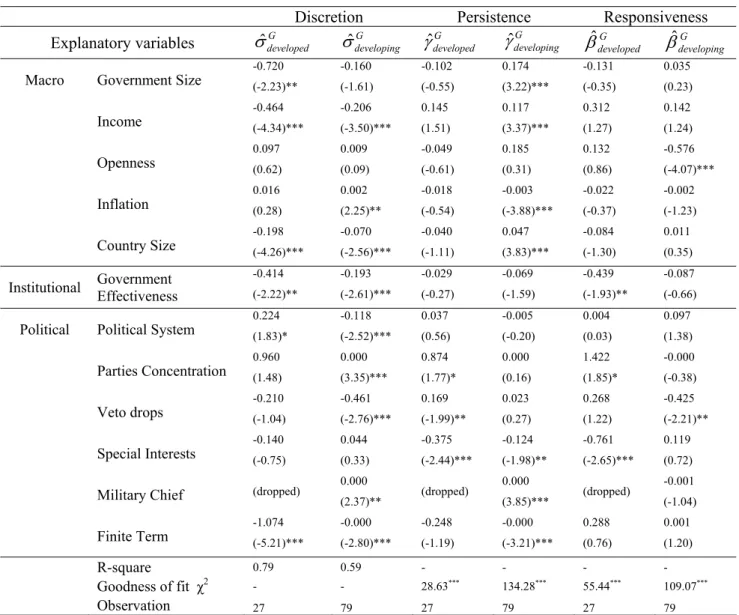Carlos Pestana Barros & Nicolas Peypoch
A Comparative Analysis of Productivity Change in Italian and Portuguese Airports
WP 006/2007/DE _________________________________________________________
António Afonso, Luca Agnello and Davide Furceri
Fiscal Policy Responiveness, Persistence and Discretion
WP 50/2008/DE/UECE _________________________________________________________
Department of Economics
WORKING PAPERS
ISSN Nº0874-4548
School of Economics and Management
Fiscal Policy Responsiveness, Persistence,
and Discretion
*
António Afonso,
#$Luca Agnello,
♦Davide Furceri
♦♠October 2008
Abstract
We decompose fiscal policy in three components: i) responsiveness, ii) persistence and iii) discretion. Using a sample of 132 countries, our results point out that fiscal policy tends to be more persistent than to respond to output conditions. We also found that while the effect of cross-country covariates is positive (negative) for discretion, it is negative (positive) for persistence thereby suggesting that countries with higher persistence have lower discretion and vice versa. In particular, while government size, country size and income have negative effects on the discretion component of fiscal policy, they tend to increase fiscal policy persistence.
JEL: E62, H50.
Keywords: Fiscal Policy, Fiscal Volatility.
* We are grateful to Jacopo Cimadomo, Javier Pérez, Ad Van Riet, Jürgen von Hagen, participants at an ECB
seminar, and to Silvia Albrizio and Matthijs Lof for research assistance. The opinions expressed herein are those of the authors and do not necessarily reflect those of the ECB or the Eurosystem.
#
European Central Bank, Directorate General Economics, Kaiserstraße 29, D-60311 Frankfurt am Main, Germany, email: antonio.afonso@ecb.europa.eu.
$
ISEG/TULisbon – Technical University of Lisbon, Department of Economics; UECE – Research Unit on Complexity and Economics, R. Miguel Lupi 20, 1249-078 Lisbon, Portugal, email: aafonso@iseg.utl.pt. UECE is supported by FCT (Fundação para a Ciência e a Tecnologia, Portugal), financed by ERDF and Portuguese funds.
♦ University of Palermo, Department of Economics, Italy, emails: furceri@.economia.unipa.it
luca.agnello@economia.unipa.it. Luca Agnello would like to thank the Fiscal Policies Division of the ECB for its hospitality.
♠
Contents
Non-technical summary ... 3
1. Introduction... 5
2. Literature... 7
3. Empirical Strategy ... 11
3.1 Fiscal Measures of Responsiveness, Persistence and Discretion... 11
3.2 What Matters for the Fiscal Measures? ... 12
4. Results and discussion ... 14
4.1 Quantitative Estimates for Responsiveness, Persistence and Discretion... 14
4.2 Determinants of the Fiscal Measures... 16
4.3 Robustness Analysis ... 21
5. Conclusion ... 23
References... 23
Appendix 1 – Data and sources ... 37
Non-technical summary
In the last decade, several studies in the economic literature have assessed fiscal policy
characteristics. Most of these studies analyze the responsiveness of fiscal policy, that is,
the response of fiscal policy to output. Other contributions analyze the extent to which
fiscal discretion impacts on the macroeconomic environment with the final objective to
solve the trade-off between the degree of fiscal discipline and the necessary flexibility to
deal with automatic stabilizers. Interestingly, few empirical studies asses the relevance of a
third fiscal policy characteristic: persistence. Generally speaking, fiscal persistence can be
considered as a measure of the degree of dependence of current fiscal behaviour on its own
past developments. We contribute to the literature by providing evidence that also accounts
for this latter fiscal characteristic.
In particular, we extend the analysis of Fatás and Mihov (2003, 2006) in several ways: i)
we also compute a measure of fiscal persistence, allowing to cross-check persistence and
discretion; ii) the abovementioned three fiscal components are obtained both for
government spending and revenue; iii) we analyse the determinants of all three fiscal
components with a set of macroeconomic, political and institutional variables, and
geographical variables; iv) finally we also use several datasets.
In order to pursue our objectives we employ a two-stage empirical strategy. In the fist
stage, we decompose fiscal policy, and in more detail government spending and revenues,
in three components: i) responsiveness, ii) persistence and iii) discretion. In the second
stage of our analysis, using the estimates of responsiveness, persistence and discretion, we
employ a cross-country analysis in order to identify the common set of economic, political
Our analysis covers a set of 132 developed and developing countries over the period
1980-2007, as well as data for EU-15 countries over the period 1970-2007. The main results of
the paper can be summarized as follows: a) fiscal policy is not responsive in most of the
countries in the sample (i.e. responsiveness is generally small and in many cases not
statistically significant) while persistence is the dominant component; b) more
interestingly, there exists a significant trade-off between persistence and discretion. Both
for revenue and spending, persistence is negatively correlated to the discretion component
thereby suggesting that countries with higher persistence have lower discretion. These
findings are supported by the results of the second part of the analysis where we carry out
a cross-country estimation approach to identify the source of fluctuations of both
persistence and discretion components. According to the previous empirical finding,
suggesting that a negative relationship between discretion and persistence exists, we find
that while government size, country size and income have negative effects on the
discretion component of fiscal policy, they tend to increase fiscal policy persistence.
Moreover, we find that macro and political and institutional variables are less relevant for
1. Introduction
In the last decade, several studies in the economic literature have assessed fiscal
policy characteristics. Most of these studies analyze the responsiveness of fiscal policy,
that is, the response of fiscal policy to output, in order to explore the effectiveness of
automatic stabilizers. Other contributions analyze the extent to which fiscal discretion
impacts on the macroeconomic environment.
Interestingly, few empirical studies asses the relevance of a third fiscal policy
characteristic: persistence. Generally speaking, fiscal persistence can be considered as a
measure of the degree of dependence of current fiscal behaviour on its own past
developments. We contribute to the literature by providing evidence that also accounts for
this latter fiscal characteristic. In particular, the aim of this paper is to disentangle fiscal
policy (both government spending and revenue) in three components: responsiveness,
persistence and discretion, and to assess which variables make these components to vary
across countries. Thus, compared to existing work on the literature, we provide a broader
and more comprehensive approach to assess the behaviour of fiscal policy (in terms of
responsiveness, persistence and discretion) and its determinants.
In particular, we extend the analysis of Fatás and Mihov (2003, 2006) in several
ways: i) we also compute a measure of fiscal persistence, allowing to cross-check
persistence and discretion; ii) the abovementioned three fiscal components are obtained
both for government spending and revenue; iii) we analyse the determinants of all three
fiscal components with a set of macroeconomic, political and institutional variables, and
geographical variables; iv) finally we also use several datasets.
From a methodological point of view, we consider the elasticity of government
revenues and expenditures to output as a measure of the fiscal responsiveness to economic
processes describing the behaviour of both government expenditures and revenues.
Finally, we identify discretion as the part of government spending and revenue that does
not correspond to systematic responses to output conditions and in past values of
government spending and revenue, but is instead the consequence of exogenous political
processes or extraordinary non-economic circumstances.
Our analysis covers a set of 132 developed and developing countries over the
period 1980-2007, as well as data for EU-15 countries over the period 1970-2007. The
main results of the paper can be summarized as follows: a) fiscal policy is a-cyclical in
most of the countries in the sample (i.e. responsiveness is generally small and in most of
the cases not statistically significant) while persistence is the dominant component; b)
more interestingly, there exists a significant trade-off between persistence and discretion.
Both for revenue and spending, persistence is negatively correlated to the discretion
component thereby suggesting that countries with higher persistence have lower discretion.
These findings are supported by the results of the second part of the analysis. In fact, we
found that regressing both discretion and persistence estimates on a common set of
explanatory variables, the sign of the coefficient associated to many of these cross-country
covariates is opposite in the two regressions.
Moreover, we find that macro and political and institutional variables can not
account for responsiveness, once regional dummies are considered.
The rest of the paper is organized as follows. Section two briefly reviews the
related literature. Section three explains the empirical strategy used to identify the
responsiveness, persistence and discretionary parts of both government spending and
revenue. It also illustrates the strategy used to identify the determinants of fiscal
presents and discusses the results. Section five concludes with the main findings, policy
implications and suggestion for future works.
2. Literature
The existing related literature has usually analyzed two of three abovementioned
components of fiscal policy. On the one hand, the responsiveness of fiscal policy to output,
and on the other hand, the discretionary part of fiscal policy. These two issues have
deserved great interest since both are crucial for output stabilization and, therefore,
indirectly for growth and aggregate welfare1.
The issue of responsiveness of fiscal policy has received increasing attention from
researchers both from a theoretical and empirical point of view.
From a theoretical point of view, standard Keynesian models imply that fiscal
policy should be counter-cyclical, i.e. government spending (taxes) should rise (decrease)
in recessions and increase in booms. At the other stream, tax-smoothing models inspired
by Barro (1979) imply that government will smooth both tax rate and government
spending by borrowing in recessions and repaying in booms, i.e. government spending will
be uncorrelated with changes in GDP, while tax revenue will be positively correlated.
From an empirical point of view, the evidence is quite mixed, varying across
spending and revenues categories as well as across countries. For OECD countries, some
research shows that spending is counter-cyclical (Gali, 1994), while others show no
discernible pattern (e.g. Fiorito, 1997; Gavin and Perotti, 1997b). The differences in these
results depend on the components of spending being measured. For example, Gali (1994)
studies government consumption and investment in a simple cross-country regression for a
sample of 22 OECD countries and finds that both taxes and government purchases seem to
1
be effectively working as "automatic stabilizers", with government purchases following a
counter-cyclical pattern. Fiorito and Kollintzas (1994) and Fiorito (1997), on the other
hand, study specifically government consumption in the G-7 countries and find that the
expenditures are either counter-cyclical or a-cyclical.
The limited number of empirical studies for developing countries suggests that
government spending tends to be pro-cyclical. For example, Gavin and Perotti (1997a)
find that fiscal policy is highly pro-cyclical in Latin America; Kaminsky, Reinhart, and
Vegh (2004) find that fiscal policy is pro-cyclical in their sub-sample of 83 low- and
middle-income countries; Braun (2001) finds that government expenditure is pro-cyclical
in a panel of 35 developing countries for the period 1970-1998.
The conventional wisdom that emerges from these studies is that fiscal policy is
counter-cyclical or a-cyclical in most developed countries, while it is pro-cyclical in
developing countries. This result is corroborated by Lane (2003) who finds that the
capability to implement fiscal control procedures is positively correlated with the level of
development (measured by output per capita). This implies that richer countries enjoy less
pro-cyclical government spending.
Several explanations have been advanced to explain the cross-country variation in
the degree of fiscal cyclicality especially between developing and industrial countries.
Important factors behind cyclicality of fiscal policy are political and institutional
ones. For example, Talvi and Vegh (2005) find that pro-cyclicality of fiscal policy is
related to political distortions. They develop an optimal fiscal policy model in which
running budget surpluses is costly because they create pressures to increase public
spending. Given this distortion, a government that faces large fluctuations in the tax base
will find it optimal to run pro-cyclical fiscal policy. Considering the differences in tax base
appears to be broadly consistent with Barro’s tax smoothing proposition, in developing
countries government spending and taxes are highly pro-cyclical.
Persson (2001), Persson and Tabellini (2001), Alesina and Tabellini (2005), also
find that political and institutional factors matter also for fiscal responsiveness. In
particular, while Persson (2001) and Persson and Tabellini (2001) find that parliamentary
and majority based systems are related to cyclicality of fiscal policy, Alesina and Tabellini
(2005) show that most of the pro-cyclicality of fiscal policy in developing countries can be
explained by high levels of corruption.
Hallerberg and Strauch (2002) argue that fiscal policy is less anti-cyclical in the
Economic and Monetary Union (EMU) countries in election years. Similar results in U.S.
states are documented by Sorensen, Wu and Yosha (2001). Using data for OECD
countries, Lane (2003) shows that countries with volatile output and dispersed political
power are the most likely to run pro-cyclical fiscal policies.
Finally, an interesting contribution is the work of Galì and Perotti (2003). After
estimating fiscal policy rules for eleven EMU countries over the period 1980-2002, they
test whether fiscal constraints of the EMU – as embedded in the Maastricht Treaty and the
Stability Growth Path – may be conducive of pro-cyclical fiscal policies. According to
their results, anti-cyclical policies became stronger after the adoption of the Maastricht
Treaty. Galì (2005) demonstrates that this latter evidence holds in general for all
industrialized countries. Afonso (2008) also finds evidence of counter-cyclical responses
of fiscal policy for the EU countries.
The second issue of fiscal policy that has been considered in the literature regards
the discretionary component of fiscal policy. A large number of studies provide evidence
that discretionary spending is strongly and negatively related to the quality of institutions
political and institutional determinants of discretionary fiscal policy and their effects on
output volatility and economic growth. They use the term discretionary to refer to changes
in fiscal positions that represent neither automatic reaction to economic conditions nor can
be related to persistent changes in budget items. Using data from 91 countries, they find
that highly volatile discretionary fiscal policy exerts a strong destabilizing effect on the
economy. Additionally, fiscal policy is explained to a large extent by such variables as the
characteristics of electoral and political systems and the lack of political constraints. They
conclude that institutional arrangements that constrain discretion via checks and balances
allow nations to achieve higher rates of economic growth and reduce macroeconomic
instability.
More recently, Fatás and Mihov (2006), using data from 48 US states, explore the
role that “rules” and institutions play in determining discretionary fiscal policy and look at
whether the same rules and institutions influence the cyclicality of fiscal policy.
Cyclicality is defined as the elasticity of government spending with respect to output. They
find that strict budgetary restrictions lead to lower policy volatility and reduce the
responsiveness of fiscal policy to output shocks. These two results should have opposite
effects on output volatility. While less discretion should reduce volatility, less
responsiveness of fiscal policy might amplify business cycles.
According to the empirical evidence reviewed above, political and institutional
variables can affect the composition of government spending in its discretionary,
persistence and responsiveness components. Thus, ultimately, it is natural to expect that
countries differ in the behaviour of both government spending and revenue along these
3. Empirical Strategy
3.1 Fiscal Measures of Responsiveness, Persistence and Discretion
Following Fatás and Mihov (2003, 2006), in order to differentiate between
persistence, responsiveness and discretion in government spending and revenue we
estimate for each country i (with i =1,…,N ) the following regressions:
( )
( )
(
)
Gt i t i G i t i G i t i G i G i t
i Y G
G, log , log , 1 , ,
log =α +β +γ − +δ Z +ε (1)
log
( )
Ri,t =αiR +βiRlog( )
Yi,t +γiRlog(
Ri,t−1)
+δiRZi,t +εiR,t (2)where G is real government spending, R is real government revenue, Y is real GDP, and Z
is a set of controls including also time trend2.
The estimates of the country-specific coefficients βi, γi and σi in (1) and in (2)
(where σi is the standard deviation of the residuals of the above regressions) will represent
respectively our measures of responsiveness, persistence, and a quantitative estimate of
discretionary fiscal policy. In order to get these estimates, we include as control variables
(i.e. the vector Zi) the current and the lagged value of real oil prices, the current inflation
rate and a linear time trend. Oil prices are included since they affect the state of the
economy and more importantly because they contribute significantly to total revenue for
some of the countries in the sample. We include inflation to ensure that our results are not
driven by high inflation episodes. We also consider a time trend in our specifications, since
government spending and revenue can also have a deterministic time trend in addition to
the stochastic one. Finally, in order to control for possible endogeneity we use past values
of real GDP as instruments.
2
3.2 What Matters for the Fiscal Measures?
Once we obtain the estimates for responsiveness ( GR i
,
ˆ
β ), persistence ( GR i
,
ˆ
γ ) and
discretion ( GR i
,
ˆ
σ ) of fiscal policy we can explain cross-country variation in fiscal policy
behaviour, regressing those estimates on a set of explanatory variables that the literature
has found to be related to fiscal policy.
We estimate the following three cross-country equations (six considering both
estimations for the spending and the revenue equation):
( )
= +∑
+∑
+∑
+j j ij j j ij j j ij i R
G
i α δ D φ P θ E ξ
σˆ , 1
log (3)
∑
+∑
+∑
++ =
j j ij j j ij j j ij i R
G
i α δ D φ P θ E υ
γˆ , 2 (4)
∑
+∑
+∑
++ =
j j ij j j ij j j ij i R
G
i α δ D φ P θ E ω
βˆ , 3 (5)
for i = 1,…, N and where: Ej denotes macroeconomic variables; Pj denotes political and
institutional variables; Dj denotes demographic and geographical variables; ω,ν, and ξ are
well-behaved residuals; α’s are nuisance coefficients; δ, φ, and θ are our coefficients of
interest.
In more detail, the set of controls consists of the following variables:3
i) Macroeconomic variables (E): a) GDP per capita; b) openness; c) GDP
deflator-based inflation rate; d) government size, and e) country size .4
ii) Political and institutional variables (P): a) an index of the level of democracy; b) an
index for political stability; c) an index for presidential versus parliamentary electoral
3
See Appendix 1 for a detailed description of the variables and sources.
4
system, d) an index that accounts for constitutional limits on the number of years the
executive can serve before new elections; e) an index of government effectiveness; f) the
Herfindahl index of parties concentration in the government, g) a dummy if the chief
executive is a military chief.5
iii) Geographical variables (D)6: a) the log of absolute latitude (kilometres from the
equator); b) regional dummies for developing countries from b1) Latin America, b2)
Sub-Saharan Africa, b3) East Asia, b4) South Asia, b5) Europe-Central Asia, b6) and Middle
East-North Africa.7
Since our dependent variables are based on estimates, the regression residuals can
be thought of as having two components. The first component is sampling error (the
difference between the true value of the dependent variable and its estimated value). The
second component is the random shock that would have been obtained even if the
dependent variable was directly observed as opposed to estimated. This would lead to an
increase in the standard deviation of the estimates, which would lower the t-statistics. This
means that any correction to the presence of this un-measurable error term will increase
the significance of our estimates8.
We estimate equations (4)-(5) by Weighted Least Squares (WLS). This choice
takes account of the fact that the dependent variables are measured with different degrees
5
The economic literature has generally focused on political and institutional characteristics to explain cross country differences in government spending (Drazen, 2000; Persson, 2001; Persson and Tabellini, 2001). See Fatás and Mihov (2003) for a more detailed discussion.
6
Alesina and Wacziarg (1998) have found that geographical variables are important to explain cross country differences in government spending.
7
As suggested by La Porta et al. (1999), it is likely that latitude from the equator, income and regional dummies are related to the quality of government and institutions.
8
of precision across countries, and of the fact that some of the estimated values of our
dependent variables are not statistically significant from zero.9
4. Results and discussion
We use data from the IMF World Economic Outlook for a set of 132 countries for
which we have data available from 1980 to 2007 (see the data Appendix for further
details).10 Moreover, using data from the European Commission AMECO database, we
perform a similar exercise for the 15 “old” members of the European Union (EU-15), for
which the time sample broadly spans between 1960 and 2007.
4.1 Quantitative Estimates for Responsiveness, Persistence and Discretion
We start our empirical analysis by estimating the coefficients of responsiveness,
discretion and persistence. The results relative to both government spending and revenue,
for the entire set of countries are reported in Table 1. Looking at the table it is possible to
see that in terms of magnitude the coefficient of persistence in the great majority of the
cases is bigger than the one of responsiveness. This is also confirmed by the fact, that
while the coefficient of persistency is statistically significant in most of the cases (73 times
for spending and 68 times for revenue) the coefficient used as our measure of fiscal
responsiveness is statistically significant for a smaller number of cases (42 times for
spending and 48 for revenue). Thus, it seems that overall, fiscal policy tends to be more
persistent than to respond to current output conditions. Moreover, it is interesting to note
that while government revenue reacts relatively more to output than government spending,
spending overall seems to be more persistent than revenue.
9
See, Lane (2003) for a similar approach. All the results presented do not qualitatively change when we estimate equations (3)-(5) by OLS.
10 We have also analyzed data from the World Development Indicator CD-ROM 2007. The results with this
We remark thatour discretion estimates are computed as the standard deviation of
the residuals from both government spending and revenue equations. Thus, it is clear that
the lower and less significant are the coefficients of responsiveness and persistence the
higher will be the component of discretion11. This argument, together with the fact that
fiscal policy seems to be more persistent than responsive, suggests a negative relation
between the measures of persistence and discretion. This intuition is empirically
confirmed. Figure 1 provides the scatter plot of our measures of persistence against
discretion exhibiting a negative relation between these two variables. In particular, the
estimate of this simple bivariate relation for the spending equation is:
( )
) 39 . 5 ( ) 89 . 0 ( ˆ log 190 . 0 09 . 0 ˆ − − − − = G i G i σ γwith R2 = 0.18 (t statistics are in parenthesis). The negative relationship also holds for the
revenue equation (see Figure 2):12
( )
) 16 . 4 ( ) 01 . 0 ( ˆ log 143 . 0 00 . 0 ˆ − − − − = R i R i σ γwith R2 = 0.12 (t statistics are in parenthesis). Thus, it seems that countries with higher
persistence have a lower discretionary component of fiscal policy. In Table 2 we also
report a rank analysis for our measure of persistence and discretion.
In order to check for the robustness of our results, we consider another data source
for both revenues and government spending: the AMECO dataset comprising data from
1960 to 2007 for European Union countries. Therefore, we have considered the “old”
EU-15 countries, with exception of Luxemburg, for which data are not available for the period
11 In fact, the lower the significance of the coefficients, the lower the R-squared of the regression, and the higher the variance of the residuals.
12 The correlation between G i
γˆ and ln
( )
σˆiG equals to -0.43 while the correlation between γˆiR and ln( )
σˆiR1988-89. For comparative purposes, we have decided to include also the United States and
Japan.
Table 3 reports parameter estimates of responsiveness, persistence and discretion
from the equations (1)-(2) over the sample period 1960-2007. We note that, while
parameter estimates G i
γˆ and R i
γˆ are always statistically significant (at 1% for all countries),
estimates ofβs are significant only for 62% of the cases (10 countries out of 16 for both
revenues and spending). Moreover, we also find a negative correlation betweenγ
coefficients and their corresponding discretionary components. In particular, we find that
the cross-country correlation betweenγˆ and iG
( )
G iσˆ
log equals -0.14 while the cross-country
correlation between R i
γˆ and
( )
R iσˆ
log is -0.32.
The above results corroborate our previous conclusions: a) persistence is the
dominant component of both government spending and revenue while evidence about their
responsiveness to the economic conditions is less clear; b) there is a negative relationship
between the degree of persistence and discretion.
4.2 Determinants of the Fiscal Measures
In the previous section we found a significant and negative relation between
discretion and persistence. On the one hand, this is partly explained by the fact that fiscal
policy is not responsive for many countries in our sample. On the other hand, these results
can be explained by the fact that if spending is left to discretionary actions and political
decision its development will be less persistent, deviating more from the trend.
However, it has to be kept in mind that we cannot infer any causal relation between
these two components of fiscal policy since they are both simultaneously determined by
macroeconomic, institutional, political and geographical variables. Thus, it is also likely to
specification for our measures of persistence and discretion. In other words we expect that
(at least for some variables) if a cross-country covariate has a negative (positive) impact on
discretion it should have a positive (negative) impact on persistence.
We start our analysis by estimating equation 3 for government spending G in order
to explain the respective discretion component. Results are reported in Table 4. In each
column of the table we present a different specification of the controls. Starting with the
first column, we can see that all the macro variables (with the exception of openness) are
significantly related to discretionary spending and with the expected sign. Discretionary
spending is negatively related to government size, since usually bigger governments have
more stable government spending and automatic stabilizers are larger (Fatás and Mihov,
2001). Income (GDP per capita) is negatively related to discretionary spending, since it is
likely that poorer countries have a more volatile business cycle due to less developed
financial markets, and at the same time may resort more often to discretionary fiscal policy
(Rand and Tarp, 2002). Inflation is positively related to higher discretionary spending
volatility, since higher inflation corresponds to higher price volatility affecting thereby
discretionary spending. Finally, smaller countries tend to have more discretion (lower
volatility of government spending). In fact, as argued by Furceri and Poplawski (2008) a
negative relationship between government spending volatility and country size can be
explained by two arguments: i) to the extent that government spending is used for fine
tuning purposes, smaller economies, characterized by more volatile output and more
exposure to idiosyncratic shocks, may use government spending more aggressively; ii) to
the extent that public goods are of a non-rival nature, increasing returns to scale of varying
government spending may originate from the higher ability to spread the cost of financing
In the second column of Table 4 we present the results obtained when institutional
variables are taken into account. While the macroeconomic variables continue to be
significant, we find that also government effectiveness is significantly and negatively
related to discretionary spending. This is in line with previous results in the literature
(Persson and Tabellini, 2001; Fatás and Mihov, 2003). Moreover, we find that considering
alternatively different proxies for the quality of institutions (voice and accountability;
political stability; regulatory quality; rule of law; and control of corruption) the results are
almost unchanged (due to the high correlation among these indicators)13.
In the third column of Table 4, we show the results when political variables are
also included. We can see that the political system proxy variables, parties’ concentration,
the dummy for military chief and for the presence for a finite term are also related to our
discretion measure. In particular, in line with Persson and Tabellini (2001), we find that
the presidential system is associated with more discretionary spending, since in a
parliamentary system the executive is supported by the parties in the parliament and
therefore is constrained in the implementation of policy by the threat of a no-confidence
vote. In a presidential system the president does not face the confidence requirement and
hence can alter more easily policy either for opportunistic or partisan reasons. Therefore,
presidential regimes may be associated with more volatile discretionary policy.
We also find that a lower concentration (lower Herfindahl index) in the
government leads to higher discretion, since proportional systems lead to coalitions and
fiscal deadlocks which delay stabilizations and increase discretionary spending (as argued
by Alesina and Perotti, 1994).
Finally, the presence of a finite term (a dummy that assumes 1 if the numbers of
mandates is limited, and 0 otherwise) makes the government more accountable and
disincentive discretionary measures (Ferejohn, 1986), while a military chief (dummy
13
assumes 1 if this is the case) tends to result in the use of fiscal policy in a more activist
way. The results are robust when we include geographical and regional variables.
We now proceed to analyze the determinants for persistence of government
spending. In Table 5 we report the results of estimating equation 4. In particular, as we did
for the estimate of our discretion equation, we report four columns each presenting a
different specification of the set of controls.
As already argued, we should expect at least for some of the controls, that if a cross
country covariate has a negative (positive) impact on discretion it should have a positive
(negative) impact on the persistence of government spending. This intuition is confirmed
by our results. In fact, looking at the first column of Table 5, we can see that most of the
macroeconomic variables are statistically significant and they have opposite signs with
respect to the volatility of spending discretion.
However there are exceptions. For example, institutional variables are not
significant in the specification for fiscal persistence but they are significant in the fiscal
discretion specification. Other variables such as military chief and finite term enter with
the same sign in both the persistence and the discretionary equation. In particular, we find
that countries with higher political stability and with a military chief have a more
persistent government spending. In contrast, countries where the executive has a given
finite term or in which the executive represent special interests have a less persistent
government spending.
Given the high correlation between spending and revenue in our sample (0.9) it is
likely to expect that the determinants of discretion and persistence have a similar effect on
spending and revenue. However, as we discussed in section 4.1, government revenue tends
components of discretion and persistence of government revenue are affected in a similar
way by our set of explanatory variables cannot be taken for granted.
In Table 6 and 7, we report the estimates of equations (3) and (4) for government
revenue. Focusing first on the revenue discretion equation (Table 6), we can observe that
similarly to the volatility of government spending discretion, government size, country
size, income, government effectiveness, parliamentary system and veto drops are
negatively associated with the discretion component of revenue. In contrast, countries with
higher inflation and characterized by lower concentration of parties tend to have more
government revenue discretion.
Analyzing the results for revenue persistence (Table 7) we can see that, as for the
spending specification, macroeconomic variables such as income and country size are
significant and they have opposite sign with respect to the revenue discretion equation. In
contrast, government effectiveness, political stability, parliamentary system and party
concentration have the same sign in both the persistence and discretion equation (Tables 6
and 7). Other variables such as military chief and finite term are only significant in the
persistence specification, and the sign of their coefficients is the same as in the spending
specification.
We conclude our analysis by assessing the cross-country determinants of
responsiveness of fiscal policy. In Table 8 we report the results of estimating equation (5)
for government spending. Starting with the first column of the table, we can see that an
only variable that is statistically significant is income. In particular, we find that developed
countries tend to be less pro-cyclical. This result is in line with other evidence in the
literature, as discussed in the previous section of the paper. However, when include the
statically significant. In contrast, as argued by Gavin and Perotti (1997a), we find that
government spending is highly pro-cyclical in Latin America.
Different results are obtained when we estimate equation (5) for government
revenue (Table 9). In particular, we find that while government size, government
effectiveness, special interests, East Asia & Pacific, and Europe & Central Asia dummies
are positively associated with revenue responsiveness, openness is negatively related. This
different behaviour between the responsiveness of government spending and revenue is
coherent with the fact that countries with pro-cyclical (counter-cyclical) spending may not
have necessarily pro-cyclical (counter-cyclical) revenue, and vice versa.
4.3 Robustness Analysis
The behaviour of fiscal policy varies across countries.Thus, it is interesting to see
whether our estimated measures of responsiveness, persistence and discretion are different
across groups of countries. To this purpose, we consider three groups of countries: EMU,
OECD and non OECD countries. Looking at the panel results reported in Table 10, it is
possible to see that the responsiveness of both expenditure and revenue to output is lower
than for the measure of persistence for all set of countries. Moreover, it does not seem that
countries significantly differ in terms of responsiveness. In contrast, country groups
systematically differ in terms of discretion and persistence of both expenditure and
revenue. In particular, EMU countries are those characterized by the lowest estimated
discretion coefficient for spending, while non OECD countries are those with the highest
(lowest) level of discretion (persistence).
It is also possible to argue that most of the variation in many determinants of
government spending and revenue, and its persistence, responsiveness and discretion
and developing countries. Thus, both from a theoretical perspective and, especially, from a
policy point of view it is important to assess whether our analysis is robust within
developed and developing country grouping. Table 11 reports the results both for the
discretion, persistence and responsiveness equations for government spending. The first
two columns refer to the results relative to fiscal discretion respectively for developed and
developing countries. Looking at these two columns, it seems that there is not much
discrepancy between the two groups. For both sets of countries, spending discretion is
negatively related to GDP per capita, country size, government effectiveness and the
dummy for finite terms. In contrast, other political variables and inflation seem to affect
spending discretion only for developing countries.
The second two columns report the results of the persistence equation for both
developed and developing countries. Differently from what was obtained for the equation
regarding the discretion component, it seems that while macroeconomic variables have
been more relevant for fiscal persistence in developing countries, political and institutional
variables in general played a role in affecting fiscal persistence in both developed and
developing countries, even if with some differences.
Finally, analyzing the last two columns we can see that the determinants of
responsiveness of government spending vary between developed and developing countries.
In particular, while government effectiveness and special interests are essentially the only
variables found to be significant in the specification for developed countries, openness and
veto drops are the only variables that have a statistically significant impact on spending
responsiveness in developing countries. This result suggests that not only the measure of
responsiveness and cyclicality varies between developing and developed countries, but this
is also true for its determinants.
5. Conclusion
By making use of a two-step estimation procedure, we pursue a twofold objective
in this paper. First, we provide an empirical study on the decomposition of fiscal policy
into three components: responsiveness, persistence and discretion. Second, we analyze the
determinants of these components. The key conclusions of our analysis are as follows.
Using a country-specific estimation approach to disentangle the abovementioned
three components of fiscal policy, both for government spending and revenue, we find
that, for most of the 132 countries in our sample, fiscal policy is rather more persistent
than responsive to current economic conditions. More interestingly, we find that, for both
revenue and spending, persistence is negatively correlated to the discretion component
thereby suggesting that countries with higher persistence have lower discretion. The above
conclusions are robust by considering the AMECO dataset for EU countries, for a larger
time span. In the second part of our analysis, we carry out a cross-country estimation
approach to identify the source of fluctuations of persistence, responsiveness and
discretion components. According to the previous empirical finding, suggesting a negative
relationship between discretion and persistence, we find that while government size and
effectiveness and income have negative effects on the discretion component of fiscal
policy, they tend to increase fiscal persistence. Moreover, we find that macro and political
and institutional variables are less relevant for responsiveness, once regional dummies are
considered.
Our study suggests possible extensions. In fact, comparing for each country the
estimates of the degree of persistence from government expenditure and revenue equations
and the starting value of these two series, one could be able to detect signals of potential
fiscal deterioration (some preliminary analysis is provided in Appendix 2).
Afonso, A. (2005). “Fiscal Sustainability: the Unpleasant European Case”, FinanzArchiv,
61 (1), 19-44.
Afonso, A. (2008). “Ricardian Fiscal Regimes in the European Union”, Empirica, 35 (3),
313–334.
Afonso, A. and Rault, C. (2007). “What do we really know about fiscal sustainability in
the EU? A panel data diagnostic”, ECB Working Paper n. 820.
Akitoby, B., Clements, B., Gupta S., and Inchauste, G. (2004). “The cyclical and
long-term behavior of government expenditures in developing countries”, IMF Working
Paper 04.202.
Alesina, A., Campante, F. and Tabellini, G. (2008). “Why is Fiscal Policy Often
Procyclical?” Journal of the European Economic Association, 6(5), forthcoming.
Alesina, A. and Perotti, R. (1994). “The Political Economy of Budget Deficits”, NBER
Working Paper 4637.
Alesina A. and Tabellini G. (2005). “Why is fiscal policy often procyclical?” mimeo, July.
Alesina, A. and Wacziarg, R. (1998). “Openness, country size and government”, Journal
of Public Economics,69 (3), 305-321.
Barlevy G. (2004). “The Cost of Business Cycles and the Benefits of Stabilization: A
Survey”, NBER Working Paper 10926.
Barro R. (1979). “On the Determination of the Public Debt”, Journal of Political
Economy, 87 (5), 93-110.
Braun M. (2001). “Why Is Fiscal Policy Procyclical in Developing Countries”, Harvard
University.
Darby, J. and Melitz, J. (2007). “Labour Market Adjustment, Social Spending and the
Automatic Stabilizers in the OECD”, CEPR Discussion Paper 6230.
Drazen, A. (2000). Political Economy in Macroeconomics, Princeton: Princeton University
Press.
Epaulard, A. and Pommeret, A. (2003). “Recursive Utility, Endogenous Growth, and the
Welfare Cost of Volatility”, Review of Economic Dynamics, 6(3), 672-684.
Fatás, A. and Mihov, I. (2001). “Government Size and Automatic Stabilizers”, Journal of
International Economics, 55, 3-28.
Fatás, A. and Mihov, I. (2003). “The Case for Restricting Fiscal Policy Discretion”,
QuarterlyJournal of Economics, 118, 1419-1447.
Fatás, A. and Mihov, I. (2005). “Policy volatility, institutions and economic growth”,
Fatás, A. and Mihov, I. (2006). “The Macroeconomics Effects of Fiscal Rules in the US
States”, Journal of Public Economics, 90, 101-117.
Ferejohn. (1986). “Incumbent performance and electoral control”, Public Choice 30, 5-25.
Fiorito R. (1997). “Stylized Facts of Government Finance in the G-7”, IMF Working
Paper 97/142.
Fiorito R. and Kollintzas T. (1994). “Stylized Facts of Business Cycles in the G7 from a
Real Business Cycles Perspective”, European Economic Review, Vol. 38, pp. 235-69.
Furceri, D. (2007). “Is Government Expenditure Volatility Harmful for Growth? A
Cross-country Analysis”, Fiscal Studies, 28 (1), 103-120.
Furceri, D., and Poplawski, M. (2008). “Fiscal Volatility and the size of Nations”, Mimeo.
Gali J. (1994). “Government Size and Macroeconomic Stability”, European Economic
Review, 38 (1), 117-32.
Galí J. (2005). “Modern perspective of fiscal stabilization policies”, CESifo Economic
Studies, 51 (4), 587-599.
Galí J. and Perotti R. (2003). “Fiscal policy and monetary integration in Europe”, Fiscal
Policy, 533-572 (October).
Gavin M. and Perotti R. (1997a). “Fiscal policy in Latin America”, NBER
Macroeconomics Annual, (12), 11-71.
Gavin M. and Perotti R. (1997b). “Fiscal policy and saving in good times and bad times”,
in Hausman R., Reisen H. (Eds.), Promoting Savings in Latin America, IDB and
OECD.
Hallerberg, M. and Strauch, R. (2002). “On the Cyclicality of Fiscal Policy in Europe”,
Empirica, 29, 183-207.
Imbs, J. (2007). “Growth and volatility”, Journal of Monetary Economics, 54 (7),
1848-1862.
Kaminsky, G., Reinhart, C. and Végh, C. (2004). “When It Rains, It Pours: Procyclical
Capital Flows and Macroeconomic Policies”, NBER Working Paper 10780.
Lane, P. (2003). “The cyclical behaviour of fiscal policy: evidence from the OECD”,
Journal of Public Economics, 87 (12), 2261-2675.
La Porta, R., Lopez de Silanes, F., Shleifer, A. and Vishny, R. (1998). “The Quality of
Government”, Journal of Law, Economics and Organization, 15 (1), 222-279.
Persson, T. (2001). “Do Political Institutions Shape Economic Policy?” NBER Working
Persson, T. and Tabellini, G. (2001). “Political Institutions and Policy Outcomes: What are
the Stylized Facts ? ” CEPR Discussion Papers 2872.
Ramey and Ramey (1995). “Cross-Country Evidence on the Link between Volatility and
Growth”, American Economic Review, 85 (5), 1138-51.
Rand, J., and Tarp, F. (2002). “Business cycles in developing countries: Are they
different?” World Development, 30 (12), 2071-2088.
Rodrick, D. (1998). “Why Do More Open Economies Have Bigger Governments?”
Journal of Political Economy, 106 (5), 997-1032.
Sorensen, B., Wu, L. and Yosha, O. (2001). “Output fluctuations and fiscal policy: U.S.
state and local governments 1978–1994”, European Economic Review, 45, 1271-310.
Talvi E. and Vegh, C. (2005). “Tax base variability and procyclical fiscal policy”, Journal
Figure 1. Scatter plot ofγˆ vs.iG G i
σˆ from country-specific spending equation.
AGO ALB ARE ARG AUS AUT BDI BEL BFA BGR BHS BLZ BOL BRA BRB BRN BTN BWA CAF CAN CHE CHL CHN CIV CMR COG COL COM CPV CRI CYP CZE DEU DMA DNK DOM ECU EGY ESP ETH FIN FRA GBR GIN GMB GNB GNQ GRC GUY HKG HTI HUN IDN IND IRL IRN ISL ISR ITA JAM JOR JPN KEN KHM KIR KOR KWT LAO LBN LBY LCA LKA LSO LUX MAR MDG MDV MEX MLI MLT MMR MOZ MRT MUS MWI MYS NER NGA NIC NLD NOR NZL OMN PAK PAN PER PHL POL PRTPRY QAT ROM
SEN SGP SLE
SLV STP SUR SWE SWZ SYC SYR TCD TGO THA TON TTO TUN TUR
TWN TZA UGA
URY USA VCT VEN VNM VUT WSM ZAF ZMB ZWE -1 -. 5 0 .5 1 gam m a (G)
-5 -4 -3 -2 -1
log sigma (G)
Figure 2. Scatter plot of R i
γˆ vs. R i
σˆ from country-specific revenue equation.
AGO ALB ARE ARG AUS AUT BDI BEL BFA BGR BHS BLZ BOL BRA BRB BRN BTN BWA CAF CAN CHE CHL CHN CIV CMR COG COL COM CPV CRI CYP CZE DEU DMA DNK DOMECU EGY ESP ETH FIN FRA GBR GIN GMB GNB GNQ GRC GUY HKG HTI HUN IDN IND IRL IRN ISL ISR ITA JAM JOR JPN KEN KHM KIR KOR KWT LAO LBN LBY LCA LKA LSO LUX MAR MDG MDV MEX MLI MLT MMR MOZ MRT MUS MWI MYS NER NGA NIC NLD
NOR NZLOMN
PAK PAN PER PHL POL PRT PRY QAT ROM SEN SGP SLE SLV STP SUR SWE SWZ SYC SYR TCD TGO THA TON TTO TUN TUR TWN TZA UGA URY USA VCT VEN VNM VUTWSM ZAF ZMB ZWE -1 .5 -1 -. 5 0 .5 1 ga m m a ( R )
-5 -4 -3 -2 -1 0
Table 1. Estimates of Responsiveness (β), Persistence (γ) and Discretion (σ)
parameter estimates (1980-2007) parameter estimates (1980-2007)
country βG βR γG γR σG σR country βG βR γG γR σG σR
Angola 0.02 0.07 -0.29 0.56** 0.16 0.19 Kuwait -0.01 1.21*** 0.6*** 0.29** 0.09 0.12
Albania 0.92 -0.5 0.63** 0.69 0.06 0.22 Lao PDR -0.77 2.71** -0.27 -0.11 0.14 0.14
United Arab
Emirates 1.74** 2.38 0.04 0.14 0.09 0.15 Lebanon -0.26 1.31 0.94*** -0.04 0.18 0.23
Argentina 1.48** 1.22 0.11 0.13 0.13 0.10 Libya 0.24 -0.47 0.54* 0.34 0.12 0.13
Australia 0.36 2.17*** 0.81*** 0.49*** 0.03 0.03 St. Lucia 0.35 0.98** 0.38** -0.08 0.08 0.07
Austria -0.05 2.1*** 0.75*** -0.12 0.02 0.03 Sri Lanka 0.78 0.05 0.3* 0.7*** 0.05 0.05
Burundi 1.49*** 2.83*** 0.06 -0.12 0.11 0.11 Lesotho 0.16 0.45 0.5*** 0.76** 0.09 0.08
Belgium -0.42 -0.38 -0.1 0.57*** 0.02 0.02 Luxembourg 0.66* 0.37 0.56** 0.44* 0.05 0.04
Burkina Faso 2.29 -0.71 -0.38 -0.19 0.12 0.22 Morocco 0.28 1.73** 0.51** 0.47** 0.05 0.07
Bulgaria 1.3*** 2.15*** 0.09 -0.23 0.06 0.07 Madagascar -2.93 23.26 0.18 -1.51 0.19 0.69
Bahamas -0.02 0.11 -0.02 0.47* 0.04 0.05 Maldives 1.32 3.27 0.15 0.22 0.13 0.22
Belize 1.5*** 0.02 0.22 0.79 0.09 0.10 Mexico 0.86 -0.2 0.19 0.19 0.18 0.15
Bolivia 1.79 -1.05 0.09 0.16 0.09 0.28 Mali -0.22 -0.74 0.3 -0.12 0.08 0.22
Brazil 0.52 -0.62 0.63 0.47 0.10 0.09 Malta 0.39 0 0.55* 0.65** 0.07 0.07
Barbados 0.83** 0.41** 0.33 0.24 0.07 0.03 Myanmar 1.21*** 0.57 -0.02 0.36* 0.10 0.13
Brunei 2.83 8.61 -0.01 0.06 0.10 0.16 Mozambique 1.22** 1.44** 0.4*** 0.62*** 0.14 0.16
Bhutan 0.3 0.23 0.24 0.23 0.14 0.13 Mauritania -2.61 -3.05 0.75*** 0.17 0.16 0.31
Botswana 0.98** 0.33 0.24 0.64*** 0.06 0.09 Mauritius 0.33 -1.14 0.6*** 0.81* 0.05 0.07
Central African
Republic 0.04 0.3 0.32** 0.24 0.17 0.23 Malawi 2.46* 3.65 -0.75 -0.35 0.20 0.23
Canada 0.18 0.38** 0.91*** 0.44** 0.02 0.02 Malaysia -0.04 0.76** 0.11 0.23 0.05 0.06
Switzerland -0.97 0.11 0.55** 0.36*** 0.02 0.02 Niger -0.16 1.99* 0.66 -0.17 0.15 0.24
Chile 0.31 0 0.77*** 0.29* 0.04 0.05 Nigeria 0.24 0.84 0.51* 0.55*** 0.25 0.20
China 1.32*** 1.32*** 0.97*** 0.93*** 0.04 0.04 Nicaragua 3.37** 3.09** 0.18 0.23 0.17 0.17
Cote d'Ivoire 0.09 0.34 0.64*** 0.79*** 0.08 0.08 Netherlands 0.81 0.69* 1.09*** 0.59*** 0.02 0.03
Cameroon 1.39*** 2.61*** 0.09 -0.27 0.09 0.20 Norway -0.92*** 0.99*** 0.27 0.55*** 0.02 0.02
Congo, Rep. 2.21** 1.08* 0.18 0.15 0.13 0.09 New Zealand 0.22 -0.49 0.79** 0.62** 0.05 0.05
Colombia 1.54*** 0.91*** 0.61*** 0.42** 0.05 0.04 Oman 0.47 0.64** 0.47** 0.59*** 0.05 0.05
Comoros 5.65 7.27 0.28 0.27 0.16 0.17 Pakistan 1.78 0.72 0.4 0.67** 0.06 0.06
Cape Verde -1.26 -0.51 0.8*** 0.58*** 0.14 0.10 Panama 0.39 0.63 0.27 0.22 0.06 0.10
Costa Rica 0.66 -0.64 -0.09 0.1 0.11 0.15 Peru -0.59 -1.16** 1.07* 0.77*** 0.12 0.16
Cyprus 0.17 -0.38 0.35** 0.58 0.04 0.04 Philippines -0.09 -0.49 0.59*** 0.94*** 0.07 0.08
Czech Republic 1.11*** 1.63*** 0.62*** 0.4** 0.04 0.04 Poland 0.75*** 0.34 0.34*** 0.65** 0.04 0.05
Germany 0.8*** 0.85*** 0.44*** 0.38*** 0.02 0.01 Portugal 0.41 0.28 0.47** 0.49** 0.07 0.07
Dominica 0.24 -0.77 0.51*** 0.75** 0.07 0.09 Paraguay 1.37*** 1.87*** 0.54*** 0.44** 0.08 0.06
Denmark -0.55** 0.77** 0.85*** 0.37** 0.01 0.02 Qatar 0.5 0.47* 0.33* 0.2 0.10 0.12
Dominican Republic 1.26* 0.15 0.4 0.28 0.12 0.12 Romania 0.52 0.58 0.54*** 0.59*** 0.06 0.07
Ecuador 4.48 0.33 0.31 0.34 0.17 0.15 Senegal 2.19*** 1.15* 0.34* 0.45 0.07 0.05
Egypt, Arab Rep. 1.78*** 0.17 0.31 0.48** 0.11 0.10 Singapore 2.92** 2.73 0.39 0.17 0.12 0.10
Spain 0.61*** 0.71*** 0.9*** 0.73*** 0.02 0.02 Sierra Leone 0.57 1.14 0.4** 0.3 0.21 0.28
Ethiopia 2.73*** 1.5 0.45*** 0.58* 0.13 0.12 El Salvador 1.58** 2.72*** 0.75*** 0.85*** 0.10 0.11 Finland 0.02 0.6*** 0.85*** 0.47*** 0.03 0.03 Sao Tome and Principe 2.14 5.99* 0.36 0.11 0.25 0.43
France 0.45* -0.07 1.07*** 0.71*** 0.01 0.01 Suriname 0.36 0.08 0.22 0.13 0.10 0.14
United Kingdom -0.16 0.82 0.76*** 0.51** 0.02 0.02 Sweden -0.21 0.94*** 0.68*** 0.32 0.02 0.02
Guinea 4.22 3.55 0.24 0.21 0.15 0.15 Swaziland 0.48 1.24*** 0.5*** 0.29** 0.08 0.06
Gambia, The -0.79 -1.68 -0.12 0.58*** 0.12 0.16 Seychelles 1.27*** -0.44 0.02 0.83*** 0.07 0.07
Guinea-Bissau 0.48 -0.04 -0.03 -0.02 0.17 0.29 Syrian Arab Republic 0.11 0.93 0.64*** 0.32* 0.08 0.09
Equatorial Guinea 0.23 0.47** 0.52*** 0.4** 0.27 0.27 Chad -0.05 0.78 0.55*** 0.77*** 0.14 0.18
Greece 0.2 -0.7 0.39 0.88*** 0.04 0.04 Togo 0.3 -0.18 0.55*** 0.56 0.11 0.22
Guyana -0.21 0.15 0.63*** 0.06 0.13 0.14 Thailand 0.78*** 1.65*** 0.91*** -0.21 0.06 0.05
Table 1 (contd.). Estimates of Responsiveness (β), Persistence (γ) and Discretion (σ)
parameter estimates (1980-2007) parameter estimates (1980-2007)
country βG βR γG γR σG σR country βG βR γG γR σG σR
Haiti -3.74 -5.82 0.97*** 0.93*** 0.28 0.36 Trinidad and Tobago 1.09*** 0.55** 0.27 0.27 0.06 0.06
Hungary 0.23 1.42*** 0.71*** 0.15 0.04 0.03 Tunisia 2.06 3.72 0.04 0.13 0.06 0.08
Indonesia 0 0.33 0.25 0.18 0.09 0.06 Turkey 0.06 0.28 0.4 0.14 0.09 0.08
India 1.23** 0.63** 0.28* -0.07 0.03 0.03 Taiwan 1.75* 1.38 0.19 -0.01 0.07 0.05
Ireland 0.26 0.31* 0.51*** 0.33* 0.03 0.03 Tanzania 0.95 0.85 0.23 0.04 0.11 0.09
Iran, Islamic Rep. 0.57 0.51 0.48** 0.64** 0.15 0.17 Uganda 1.28 2.02* 0.16 0.08 0.17 0.18
Iceland 0.56** 0.82*** 0.63*** 0.32** 0.03 0.03 Uruguay 0.84*** 1.05** 0.47** 0.41* 0.05 0.06
Israel 0.77*** 0.33 0.48*** 0.37* 0.02 0.05 United States 0.27 1.05*** 0.83*** 0.51** 0.01 0.03
Italy 1.15*** 0.68* 0.81*** 0.8*** 0.02 0.02
St. Vincent and the
Grenadines -0.07 -1.31 0.58* 0.59* 0.09 0.08
Jamaica -1.1 -1.24 0.4** 0.57** 0.07 0.10 Venezuela, RB 1.07 -0.29 -0.04 0.63 0.11 0.11
Jordan 0.42 0.07 0.36 0.24 0.11 0.09 Vietnam -1.15 -1.27 0.28 0.83*** 0.14 0.10
Japan 0.4** 1.1*** 0.83*** 0.42 0.02 0.03 Vanuatu 0.95 1.21** 0.47** 0.35** 0.13 0.12
Kenya 0.96** 0.47* 0.26 0.62*** 0.08 0.05 Samoa -1.4 0.37 0.49** 0.36* 0.10 0.14
Cambodia -11.96* -9.63** -0.72 -0.37 0.22 0.27 South Africa -0.59 0.69* 0.68*** 0.49** 0.03 0.03
Kiribati 0.97** 0.15 0.14 0.25 0.14 0.18 Zambia 0.9 -0.27 0.3 -0.21 0.11 0.14
Korea, Rep. 0.25 0.03 0.88*** 0.51*** 0.04 0.04 Zimbabwe 0.08 -0.35 0.63* 0.88*** 0.16 0.13
Notes: E – expenditure; R – revenue. *, ***, ***, significant at respectively 10, 5, and 1 per cent.
Table 2. Spearman correlation matrix
γG γR σG σR
γG
1
γR
0.395 1
σG
-0.391 -0.279 1 σR
-0.388 -0.309 0.900 1
Table 3. Results with AMECO dataset
parameter estimates (1960-2007)
country βˆG βˆR γˆG γˆR σˆG σˆR
Austria 0.59*** 0.52** 0.78*** 0.76*** 0.02 0.02
Belgium 0.97*** 0.39* 0.66*** 0.79*** 0.03 0.01
Germany 0.51** 0.42* 0.73*** 0.73*** 0.02 0.03
Denmark 0.36 1.15* 0.90*** 0.68*** 0.03 0.04
Spain 0.28* 0.39 0.99*** 0.93*** 0.02 0.03
Finland 0.24* 0.39*** 0.93*** 0.80*** 0.04 0.04
France 0.06 -0.15 0.90*** 1.03*** 0.01 0.02
United Kingdom 0.47* 0.54** 0.85*** 0.81*** 0.04 0.03
Greece 0.08 0.16 0.88*** 0.77*** 0.04 0.03
Ireland -0.01 -0.02 0.69*** 0.65*** 0.04 0.03
Italy 0.59*** 0.14 0.75*** 0.89*** 0.02 0.03
Netherlands 0.46*** 0.55*** 0.85*** 0.81*** 0.02 0.02
Portugal 0.44*** 0.5*** 0.86*** 0.67*** 0.04 0.04
Sweden -0.39 0.03 0.77*** 0.79*** 0.03 0.03
United States 0.28 0.76*** 0.83*** 0.59*** 0.02 0.02
Japan 0.32*** 0.27*** 0.77*** 0.78*** 0.04 0.03
Table 4. Determinants of Spending Discretion (σˆiG)
Explanatory variables 1 2 3 4
Macro Government Size -0.198 (-2.49)*** -0.206 (-2.69)*** -0.177 (-2.00)** -0.180 (-1.86)* Income -0.497 (-12.48)*** -0.298 (-5.72)*** -0.262 (-5.06)*** -0.332 (-5.44)*** Openness 0.016 (0.15) 0.072 (0.76) 0.094 (0.93) 0.089 (0.78) Inflation 0.005 (7.85)*** 0.002 (3.23)*** 0.002 (1.92)* 0.002 (3.27)*** Country Size -0.103 (-4.54)*** -0.090 (-4.27)*** -0.103 (-4.50)*** -0.091 (-3.05)***
Institutional Government Effectiveness -0.327 (-5.32)*** -0.326 (-5.73)*** -0.192 (-2.42)** Political Political System -0.135 (-2.85)*** -0.100 (-1.93)* Parties Concentration 0.001 (3.99)*** 0.000 (2.22)** Veto drops -0.191 (-1.62) -0.194 (-1.52) Special Interest 0.072 (0.60) 0.127 (1.13) Military Chief 0.001 (3.90)*** 0.000 (1.81)* Finite Term -0.000 (-2.81)*** -0.000 (-2.25)** Geographical
Distance from Equator
0.000
(0.01)
East Asia & Pacific
0.333
(1.94)*
Europe & Central Asia
0.074
(0.47)
Latin America & Caribbean
0.470
(2.48)**
Middle East & North Africa 0.279 (1.22) South Asia -0.028 (-0.14) Sub-Saharan Africa 0.113 (0.66)
R-square 0.67 0.73 0.78 0.82
Observations 111 110 106 106
Table 5. Determinants of Spending Persistence (γˆiG)
Explanatory variables 1 2 3 4
Macro Government Size 0.083 (2.29)*** 0.080 (2.19)*** 0.146 (2.93)*** 0.133 (2.61)*** Income 0.108 (7.78)*** 0.124 (5.07)*** 0.126 (4.94)*** 0.098 (2.84)*** Openness -0.444 (-1.15) -0.043 (-1.10) -0.012 (-0.29) 0.013 (0.28) Inflation -0.003 (-4.07)*** -0.003 (-4.12)*** -0.003 (-3.85)*** -0.003 (-3.72)*** Country Size 0.039 (4.01)*** 0.039 (3.96)*** 0.041 (3.78)*** 0.047 (3.46)***
Institutional Government Effectiveness -0.022 (-0.78) -0.019 (-0.61) -0.024 (-0.68) Political Political System 0.008 (0.38) -0.009 (-0.41) Parties Concentration -0.000 (-0.10) 0.000 (0.64) Veto drops 0.113 (-2.03)** 0.119 (2.08)** Special Interest -0.125 (-2.42)** -0.150 (-2.86)*** Military Chief 0.001 (3.49)*** 0.000 (3.62)*** Finite Term -0.000 (-3.32)*** -0.00 (-3.07)*** Geographical
Distance from Equator
0.001
(0.91)
East Asia & Pacific
-0.095
(-1.03)
Europe & Central Asia
-0.132
(-1.51)
Latin America & Caribbean
-0.088
(-1.36)
Middle East & North Africa -0.248 (-2.78)*** South Asia -0.363 (-3.18)*** Sub-Saharan Africa -0.059 (-0.66)
Goodness of fit χ2 214.63*** 213.73*** 182.85*** 160.93***
Observation 111 110 106 106
Table 6. Determinants of Revenue Discretion (σˆiR)
Explanatory variables 1 2 3 4
Macro Government Size -0.254 (-2.63)*** -0.288 (-2.96)*** -0.282 (-2.86)*** -0.286 (-2.92)*** Income -0.521 (-11.29)*** -0.298 (-3.81)*** -0.244 (-3.12)*** -0.306 (-3.45)*** Openness -0.072 (-0.59) -0.021 (-0.20) -0.042 (-0.43) -0.069 (-0.59) Inflation 0.005 (11.65)*** 0.002 (2.04)** 0.001 (1.69)* 0.002 (2.18)** Country Size -0.130 (-4.52)*** -0.129 (-4.63)*** -0.162 (-6.33)*** -0.166 (-4.90)***
Institutional Government Effectiveness -0.356 (-4.24)*** -0.366 (-4.62)*** -0.276 (-3.00)*** Political Political System -0.163 (-3.39)*** -0.171 (-3.43)*** Parties Concentration 0.001 (2.47)** 0.000 (1.84)* Veto drops -0.233 (-1.82)* -0.244 (-1.79)* Special Interest -0.091 (-0.80) -0.049 (-0.46) Military Chief 0.000 (0.77) -0.000 (-0.02) Finite Term -0.000 (-0.88) -0.000 (-0.52) Geographical
Distance from Equator
-0.000
(-0.12)
East Asia & Pacific
0.241
(1.30)
Europe & Central Asia
0.112
(0.64)
Latin America & Caribbean
0.217
(1.22)
Middle East & North Africa 0.043 (0.19) South Asia -0.196 (-0.77) Sub-Saharan Africa -0.032 (-0.16)
R-square 0.63 0.68 0.77 0.78
Observation 111 110 106 106
Table 7. Determinants of Revenue Persistence (γˆiR)
Explanatory variables 1 2 3 4
Macro Government Size 0.063 (1.62)* 0.064 (1.66)* 0.098 (1.96)** 0.067 (1.28) Income 0.021 (1.32) 0.069 (2.36)** 0.068 (2.28)** 0.066 (1.62)* Openness 0.023 (0.50) 0.018 (0.39) 0.113 (2.23)** 0.059 (0.98) Inflation -0.000 (-0.20) -0.000 (-1.03) -0.000 (-0.94) -0.000 (-0.67) Country Size 0.039 (3.85)*** 0.040 (3.89)*** 0.045 (4.03)*** 0.052 (3.49)***
Institutional Government Effectiveness -0.063 (-1.95)** -0.027 (-0.71) -0.002 (-0.05) Political Political System -0.071 (-2.71)*** -0.060 (-2.10)** Parties Concentration 0.000 (2.55)*** 0.000 (2.73)*** Veto drops 0.184 (3.00)*** 0.184 (2.93)*** Special Interests -0.008 (-0.16) -0.031 (-0.57) Military Chief 0.001 (2.89)*** 0.000 (2.64)*** Finite Term -0.000 (-2.89)*** -0.000 (-2.94)*** Geographical
Distance from Equator
0.004
(3.42)***
East Asia & Pacific
0.102
(0.98)
Europe & Central Asia
-0.109
(-0.94)
Latin America & Caribbean
0.016
(0.20)
Middle East & North Africa 0.002 (0.02) South Asia -0.210 (-1.67)* Sub-Saharan Africa 0.088 (0.77)
Goodness of fit χ2 254.04*** 250.07*** 219.30*** 195.74***
Observation 111 110 106 106
Table 8. Determinants of Spending responsiveness ( G i
βˆ )
Explanatory variables 1 2 3 4
Macro Government Size -0.069 (-0.66) -0.045 (-0.42) -0.050 (-0.39) -0.202 (-1.42) Income -0.176 (-4.68)*** -0.086 (-1.29) -0.048 (-0.66) -0.155 (-1.53) Openness -0.145 (-1.81)* -0.128 (-1.59) -0.098 (-1.14) -0.170 (-1.57) Inflation -0.000 (-0.65) -0.001 (-1.38) -0.001 (-1.32) -0.000 (-0.06) Country Size -0.000 (-0.02) 0.012 (0.53) 0.008 (0.32) 0.042 (1.25)
Institutional Government Effectiveness -0.106 (-1.59) -0.158 (-1.95)** 0.015 (0.16) Political Political System -0.003 (-0.06) 0.038 (0.74) Parties Concentration 0.000 (0.76) 0.000 (0.20) Veto drops 0.045 (0.34) -0.038 (-0.28) Special Interests -0.187 (-1.53) -0.212 (-1.64) Military Chief -0.000 (-0.52) -0.001 (-1.15) Finite Term 0.001 (0.99) 0.001 (1.18) Geographical
Distance from Equator
0.011
(3.82)***
East Asia & Pacific
0.082
(0.36)
Europe & Central Asia
0.316
(1.66)*
Latin America & Caribbean
0.462
(3.00)***
Middle East & North Africa 0.240 (0.95) South Asia 0.473 (1.33) Sub-Saharan Africa 0.035 (0.15)
Goodness of fit χ2 220.48*** 215.40*** 204.56*** 176.77***
Observation 111 110 106 106
Table 9. Determinants of Revenue responsiveness ( R i
βˆ )
Explanatory variables 1 2 3 4
Macro Government Size 0.219 (1.95)** 0.206 (1.78)* 0.413 (3.18)*** 0.235 (1.63)* Income -0.011 (-0.28) 0.014 (0.21) -0.025 (-0.33) 0.006 (0.06) Openness -0.028 (-0.31) -0.031 (-0.34) -0.060 (-0.62) -0.395 (-3.19)*** Inflation -0.002 (-1.96)** -0.002 (-1.92)** -0.003 (-2.40)** -0.002 (-1.26) Country Size 0.000 (0.04) -0.003 (-0.12) 0.003 (0.10) -0.049 (-1.44)
Institutional Government Effectiveness -0.032 (-0.48) 0.045 (0.49) 0.214 (2.09)** Political Political System -0.023 (-0.43) -0.053 (-0.89) Parties Concentration -0.000 (-2.03)** -0.000 (-1.74)* Veto drops 0.089 (0.69) 0.081 (0.61) Special Interests 0.317 (2.65)*** 0.275 (2.20)** Military Chief 0.000 (0.25) -0.000 (-0.25) Finite Term 0.000 (0.49) 0.000 (0.78) Geographical
Distance from Equator
0.009
(2.56)***
East Asia & Pacific
0.770
(3.30)***
Europe & Central Asia
0.906
(3.75)***
Latin America & Caribbean
0.050
(0.30)
Middle East & North Africa 0.345 (1.46) South Asia 0.259 (0.84) Sub-Saharan Africa 0.334 (1.26)
Goodness of fit χ2 262.78*** 262.32*** 237.07*** 212.55***
Observation 111 110 106 106
